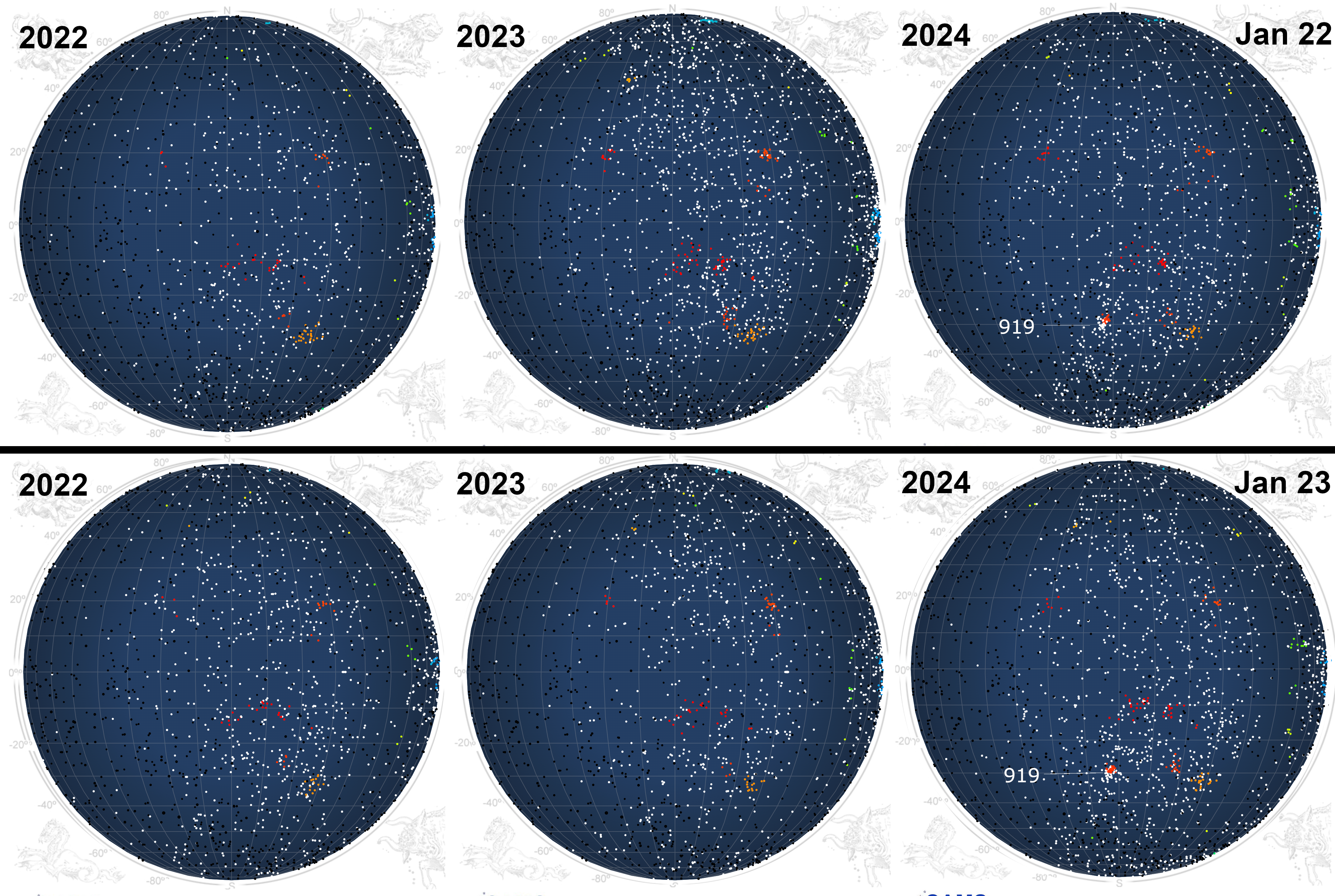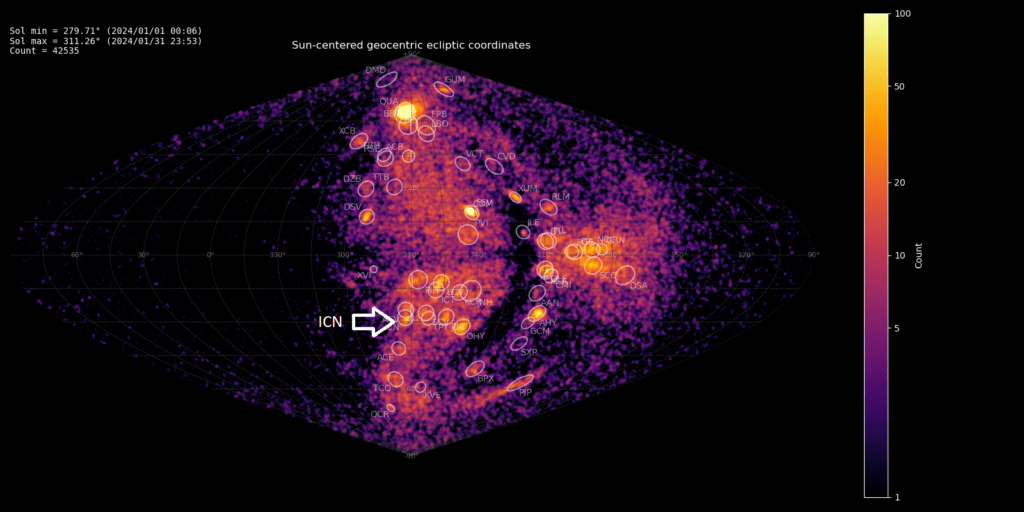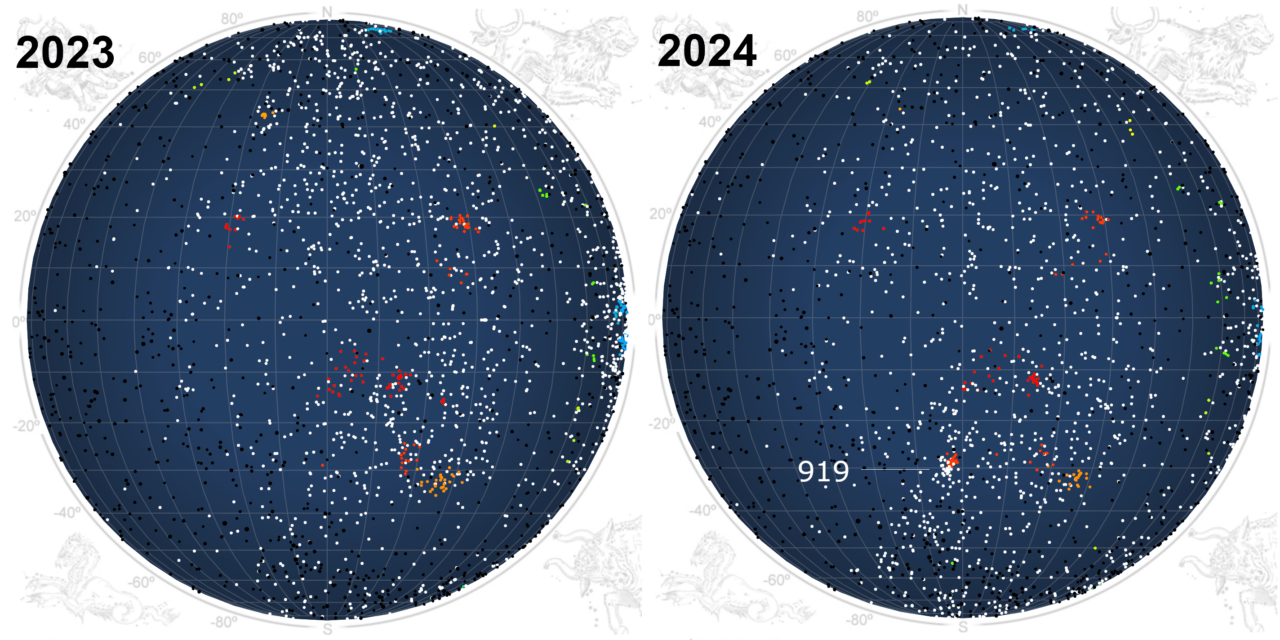Abstract: The iota-Centaurids (ICN#919) meteor shower, in other years a minor shower, displayed enhanced activity in 2024 of relatively long duration. The outburst was observed by both the southern hemisphere CAMS networks and the Global Meteor Network. The parent body is unknown. The orbital elements suggest the source is a Halley-type or long-period comet, with the meteoroids hitting Earth now in a relatively short semi-major axis of 4.8 AU. That makes it possible that the unusual activity is due to dust trapped in mean-motion resonance with Jupiter.
Introduction
The iota-Centaurids (ICN#919) were first identified as a minor shower by Jenniskens et al. (2018) in southern hemisphere CAMS data from the years 2011 to 2016, mostly based on CAMS New Zealand results. In some years, the shower was detected also from California and by the SonotaCo network in Japan, where the radiant elevation remained low. This meteor shower in the southern apex source was found active during the period January 16-25 (λʘ 296° to 305°), radiating from a radiant αg =199° and δg =-38.9° with vg = 63.9 km/s at about λʘ = 301.1°. Based on more expansive 2020–2023 data, Jenniskens (2023) put the radiant at αg =197.4° and δg =-37.8° with vg = 64.4 km/s, peaking at about λʘ = 299.5°. That speed translates to a relatively short orbit with median semi-major axis a = 4.78 AU.
In the years 2022 and 2023, the shower remained unassuming, but not so in 2024. T. Cooper of CAMS South Africa first pointed out that this shower appeared to be unusually strong in early CAMS data. When all results had come in, including observations from the Global Meteor Network, the shower was clearly much stronger than in previous years (Fig. 1).
 Figure 1 – The dense concentration of shower 919 radiants can be seen on the combined video-derived radiant maps from CAMS and GMN data for 2024 January 21/22 (top) and January 22/23 (bottom), compared to the same map at the same date in the previous two years (From near-real-time map at: http://cams.seti.org/FDL/).
Figure 1 – The dense concentration of shower 919 radiants can be seen on the combined video-derived radiant maps from CAMS and GMN data for 2024 January 21/22 (top) and January 22/23 (bottom), compared to the same map at the same date in the previous two years (From near-real-time map at: http://cams.seti.org/FDL/).
Enhanced activity in 2024
In 2024, this meteor shower showed stronger than usual activity (Jenniskens et al., 2024) during 2024 Jan. 21-26, corresponding to λʘ = 301.0 to 306.0 deg (equinox J2000.0). Forty-eight iota Centaurids were triangulated by CAMS New Zealand, coordinated by J. Baggaley (University of Canterbury) and J. Scott (University of Otago); 34 shower meteors by CAMS Australia, via H. Devillepoix (Curtin University) and D. Rollinson; 16 shower meteors by CAMS Chile, via S. Heathcote and T. Abbott (NOIRLAB/Cerro Tololo) and E. Jehin (University of Liege), 2 shower meteors by a mostly clouded CAMS Namibia, via T. Hanke (H.E.S.S. Collaboration), and 1 shower meteor by the northern-hemisphere United Arab Emirates Astronomical Camera Network, via M. Odeh (International Astronomical Center).
The dense radiant concentration in 2024 is obvious in Figure 1, where the radiant maps for January 21/22 and 22/23, 2024 are compared to previous years at the same date. To quantify the increase in activity, the annual ratio of triangulated iota-Centaurids to all sporadic meteors for these networks for the past 5 years was calculated as follows:
- 2020: 0.0037 ± 0.0009
- 2021: 0.0038 ± 0.0010
- 2022: 0.0018 ± 0.0007
- 2023: 0.0034 ± 0.0009
- 2024: 0.0145 ± 0.0015
In 2024 rates were above normal, peaking at 302.4 ± 0.1 deg. The time of the peak is later than in normal years, and also the activity period extended a little longer (cf., Jenniskens 2023). After plotting the detected number of meteors and comparing those to the total number detected iota-Centaurids in prior years, it showed that activity was normal prior to January 21, but then increased above normal activity, increasing exponentially to a peak and then decreasing exponentially with a full-width-at-half maximum duration of about 1.6 deg.
The median orbital elements are shown in Table 1 and are compared to the orbit for the iota-Centaurids in Jenniskens (2023). This identifies the outburst as due to this previously known minor shower. The 2024 observations nearly double the number of known orbits for this shower.
Table 1 – The 2024 orbital elements (Equinox J2000.0) compared to the median 2013–2023 orbit from Jenniskens (2023).
| 2023 | 2024 | |
| λʘ (°) | 299.5 | 302.4 |
| αg (°) | 197.4 | 200.6 |
| δg (°) | -37.8 | -40.3 |
| vg (km/s) | 64.4 | 63.7 |
| λ – λʘ (°) | 271.9 | 272.8 ± 1.0 |
| β (°) | -28.0 | -29.1 ± 0.9 |
| a (AU) | 4.78 | 4.7 |
| q (AU) | 0.981 | 0.979 ± 0.005 |
| e | 0.795 | 0.790 ± 0.086 |
| ω (°) | 353.6 | 350.8 ± 3.4 |
| Ω (°) | 119.6 | 122.4 ± 1.7 |
| i (°) | 131.4 | 129.4 ± 1.5 |
| Π (°) | 113.2 | 113.2 |
| Tj | 0.30 | 0.39 |
| N | 113 | 101 |
These results include the CAMS-derived orbits from Global Meteor Network (Vida et al., 2020; 2021) stations in Australia (D. Rollinson) and New Zealand (J. Scott). These and other southern hemisphere stations participating in GMN confirm the detection independently from the CAMS observations in Chile. The iota-Centaurids (ICN) this year were found so strong that the shower is recognized even in the combined GMN data for January 2024 (Figure 2).

Figure 2 – Radiant plot of the Global Meteor Network for 2024 January in Sun-centered geocentric ecliptic coordinates (From: https://globalmeteornetwork.org/data/).
Discussion
The parent body is unknown. The short semi-major axis and long-duration activity suggest that the 2024 activity might be dust from a Halley-type comet trapped in the 1:1 mean-motion resonance with Jupiter. Indeed, the shower was also detected by northern-hemisphere CAMS and SonotaCo stations, with a low radiant elevation, in 2013 during solar longitudes 300.6-302.5 deg.
References
Jenniskens P., Baggaley J., Crumpton I., Aldous P., Pokorny P., Janches D., Gural P. S., Samuels D., Albers J., Howell A., Johannink C., Breukers M., Odeh M., Moskovitz N., Collison J. and Ganjuag S. (2018). “A survey of southern hemisphere meteor showers”. Planetary Space Science, 154, 21–29.
Jenniskens P. (2023). Atlas of Earth’s Meteor Showers. Elsevier, USA. page 525.
Jenniskens P., Baggaley J., Scott J., Devillepoix H., Rollinson D., Heathcote S., Abbott T., Jehin E., Hanke T., Odeh M. (2024). “Iota Centaurid meteor shower”. CBET 5347. D.W.E. Green (ed.), IAU Central Bureau for Astronomical Telegrams, 1 pp.
Vida D., Gural P.S., Brown P.G., Campbell-Brown M. and Wiegert P. (2020). Estimating trajectories of meteors: an observational Monte Carlo approach–I. Theory. Monthly Notices of the Royal Astronomical Society, 491, 2688-2705.
Vida D., Segon D., Gural P.S., Brown P.G., McIntyre M.J., Dijkema T.J., Pavletic L., Kukic P., Mazur M.J., Eschman P. and Roggemans P. (2021). The Global Meteor Network – Methodology and first results. Monthly Notices of the Royal Astronomical Society, 506, 5046-5074.


